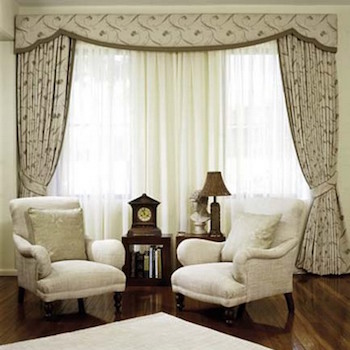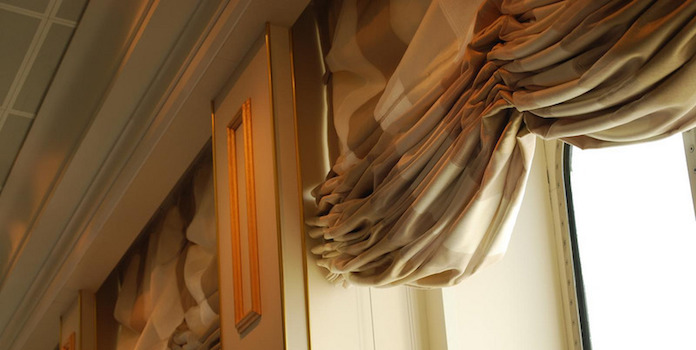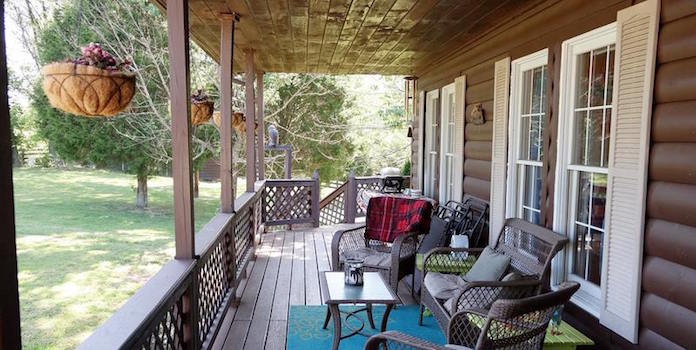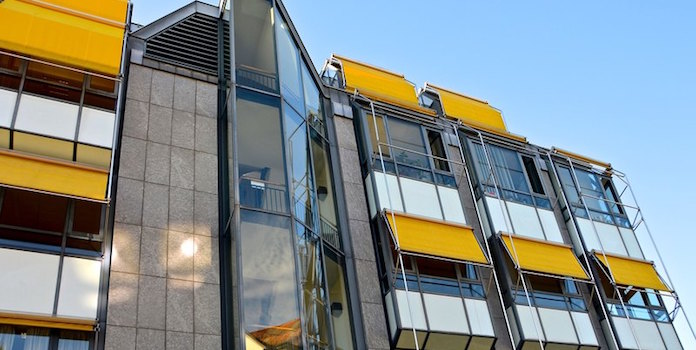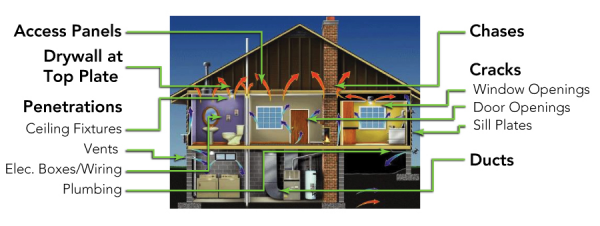Energy Saving Curtains and Other Window Improvements

Energy efficiency in the home will lower energy costs.
How can energy saving curtains, awnings, and blinds make a difference in your home?
In many of the posts on this blog, we talk about solar energy, how to ensure that your solar system is performing well, and giving you tips so that you are generating as much power as possible for your needs. Just as important, however, is what happens to that energy after it has been created and used to power things in your home, such as your air conditioner or heater.
Houses are ripe with opportunities for cracks, crevices, and other openings that allow your cooled (or heated) air to escape. Even more insidious is the fact that a lot of that energy escapes right through your windows, even if they are closed!
Let’s find out how to use energy saving curtains, awnings, and other methods to drastically reduce the amount of energy that is leaking out of your home.
How much energy is lost through windows?
Did you know that about 15% of the heat in your home goes out the window in winter? This is because windows typically make up about 15-20% of the surface area of your walls, and they aren’t usually insulated nearly as well as the walls of your home.
Why is this the case?
To understand how energy escapes through the windows, we’ll need to learn a couple of terms used in the heating and cooling industry that show how well different materials insulate. These terms are:
- R-Value – This is a value placed on the thickness of material, and it measures the resistance of heat transfer through that material. If a structure is made of more than one material combined together (like insulation, drywall, etc.), then this number is usually found by adding up the R-value of the individual layers.
- U-Value – More of an engineering term, the U-value is typically used to measure the thermal performance of a whole system (like a window assembly) which is made of different parts and is responsible for various things (like controlling UV rays and creating ventilation).
Both of these terms are used to compare items related to home energy efficiency and insulation. It’s just important to know that the higher the R-value, the better that material is for insulating and the lower the U-value the better. Don’t get confused, I promise we won’t be using much math!
Ways to reduce energy loss through windows
Now that we know a little bit about how to define the amount of energy escaping through windows, as well as how we rate different items that help to reduce this loss, we can start to look at the elements that can contribute to improving efficiency.
As we go through these options, note that they break down into a few basic categories: interior, exterior, and the windows themselves. The differences in these categories mean that there are an enormous amount of options for your home depending on your individual needs.
For instance, if you want to enjoy an outdoor lounging space, using an oversized awning over large windows could be a great way to incorporate potential energy savings into your plans for personal space and aesthetics.
I want to emphasize that finding the one, best solution for each window space is ideal – in many cases, it would be a little redundant to use all of the methods over one window. Many of these individual methods, as we’ll see, tend to capture most of the potential energy savings on their own!
Note that I’m not including window weatherization (caulking around trim, for instance) here as this is a no-brainer in most cases, and should always be used!
#1 Energy-saving curtains and draperies
Most people have some sort of curtains or drapes hung over their windows. Although they are commonly chosen for aesthetics, they can also serve to cut down on escaping energy! They do this in two ways: preventing inside air from touching the windows and blocking light altogether. In order to achieve these goals, however, a little planning is required beyond color scheme.
Imagine for a moment the air that is circulating throughout your home. If it is the wintertime, your furnace or HVAC unit is pumping out hot air to help normalize the temperature in the home. This air is bumping into ceilings, walls, and windows as it flows through your house.
Because windows often have a lower R-value than your walls, they act as a cold source when the hot air bumps into them.
Remembering that hot air rises and cool air sinks, the air from your heater will start to touch the glass window, cool down, and fall lower in the room. As the cooler air lowers, new warm air replaces it endlessly. It creates a cold draft, and your heater will have to use more energy to compensate for this loss of heat.
For curtains to save energy, they will need to be held as tightly to the wall and window as possible to prevent any air from making contact with the windows themselves. The composition of the curtains is also critical. It is impossible to generalize every curtain available, but a good one should include materials meant to control energy loss. Ideally, they should include:
- Fabric that doesn’t allow air to pass through it easily (closed weave, etc.)
- Some insulating layer (dense material, foam insulation, etc.)
- Long length (to reach well past the bottom of the window)
- A pelmet on top to prevent air from coming down through the gap created by the curtain rod (refer to the above illustration)
- Some way to fasten or attach the curtains to the wall when fully closed (such as a magnet or hooks)
If these criteria are met, this could mean up to a 10% reduction in heat loss during the winter and reduce heat gains by 33% in the summer (depending on the color)!
#2 Interior blinds and shades
Interior blinds are another method that can easily add style to your home while also helping to curb energy loss during peak season. The disadvantage to using blinds is that the openings between slats make it hard to control heat loss in the winter since they can’t do much to stop the flow of hot and cold air moving against the window.
If you’re dead set on blind though, this disadvantage can be largely sidestepped by deploying a collapsible shade with clamps or a roller track, such as a Roman shade, that doesn’t have gaps for air to pass through.
Their advantage, however, comes during the summer because they will then offer some flexibility in controlling light and ventilation. Specialized blinds with a reflective coating can reduce heat gain by around 45% when used correctly. This reduction could be pretty significant during the hottest months!
Roman shades sealed along the top and sides can provide up to a 60-75% heat reduction (pg. 5) provided that the seal is continuous around the window such as a roller track or wooden clamp along the sides. As always, air contact is the bane of window efficiency!
#3 External panels and shutters
Many homes feature shutters around windows on the outside of the house, but often these shutters are purely for cosmetic purposes and have no actual function.
To get some real value out of an external shutter, they need to be able to tightly cover the window so that they can block the light and air flow through the glass. Options are endless for shutters, and they can be designed and built to be permanently attached during the heating season or to be opened and closed easily.
They can also be constructed from a variety of materials depending on the needs of the homeowner. For someone looking to maximize their heating efficiency, multiple layers can be incorporated into the shutter to increase its insulation and R-Value.
A typical R-Value for these types of shutters is about 4.0, or 75% effectiveness, but could be as high as 10.0–90% effectiveness (see link above, pgs. 6-7). Depending on the materials used, these types of shutters could also double as storm protection along the coast when windows can be a liability for things other than energy efficiency!
#4 Awnings and overhangs
Another great option for reducing the heat coming through your windows during the summertime is an awning or a similar overhanging structure that can block and reflect light. In fact, up to 65% of the heat on south-facing windows and 77% on west-facing windows can be eliminated with an awning!
The great thing about this option is that they can often provide some extra utility besides just energy efficiency. A nice awning over a back porch, for instance, can provide a cooler outdoor space to enjoy while still having access to fresh air and fun outside!
![]() Separate from the more typical back porch awning are options for apartments and condos such as in the image above. These are a bit of a hybrid between the awning and an exterior blind and can allow high-rise dwellers to open their windows and enjoy the outdoor air without getting the sun’s full heat!
Separate from the more typical back porch awning are options for apartments and condos such as in the image above. These are a bit of a hybrid between the awning and an exterior blind and can allow high-rise dwellers to open their windows and enjoy the outdoor air without getting the sun’s full heat!
#5 Low-E window films
Since we’ve been dealing with a lot of R-Values and U-Values, I think that it is time to throw another term your way! The “E” in Low-E windows stands for emissivity, and this value defines how well glass reflects light and heat back from its surface. Think about the tinting on a car window, and you’ll be in the right ballpark for how these types of films work.
A window coating could provide a lot of benefits if you live in a hotter climate year-round because of their heat blocking properties. To put things in perspective, a standard clear glass window has an emittance of .84, allowing 84% of the solar energy striking the window to heat up and pass through the glass. In comparison, some newer Low-E coatings can have an emittance rating as low as .04, meaning only 4% of that energy passes through the glass!
One potential downside to using these types of films revolves around how much visible light you want to enter your home. If you want to have a bright window to use as a light source, then you will need to be careful that your film has a high transparency. Some less sophisticated types of coating rely heavily on reducing the amount of visible light to prevent heat entering the home.
The good news is that if reducing light is your goal then there are many options! Low-E window films are very common in modern, window-dominant high-rise buildings because they can improve insulation performance significantly, leading to an attractive ROI for builders and owners.
All of the above solutions revolve around the idea that you want to reduce the amount of heat entering your home, but the film can also be applied to the interior of the window as well, which can provide heat blocking from the inside. In colder climates, this could be a significant benefit to your home heating system as less of your heat escapes through the windows once it is produced!
#6 Window sealing and weatherstripping
Most of the projects above require a decent amount of investment to capture their big savings. As far as small projects go, however, sealing cracks around the house with weatherstripping is an inexpensive way to save some money on your heating and cooling bill.
Taking advantage of this method will help you save between 5-10% depending on how much air your house is currently leaking.
The process is pretty straightforward and you can easily knock it out yourself. Check out This Old House’s Guide to Weatherstripping for more info. Adding weatherstripping rarely requires any modifications to your existing hardware, and it is a very low-risk/high-reward application.
Worthwhile energy-saving options in any home
Although it would be impossible to match the energy efficiency of an insulated wall, there are lots of ways that window openings can be modified to minimize heat loss and/or gain while simultaneously improving the look and feel of your home!
No matter your budget or needs, there is an option out there for you!
If you wish to go one step further and invest in energy saving appliances, read our post: How to Calculate Energy Efficiency Ratio. Interested in going solar? Check out our guide to solar as well!
What have you done to reduce your energy consumption? What would you have done differently? Let us know in the comments!
Image Credit under CC License via Flickr – 1, 2, 3 & Pixabay – 4, 5, 6 & EPA 7

